 Via The Adventure Blog : ExWeb posts an interview with climber Danielle Fisher. A good read.
Via The Adventure Blog : ExWeb posts an interview with climber Danielle Fisher. A good read.
Results matching “Bird”
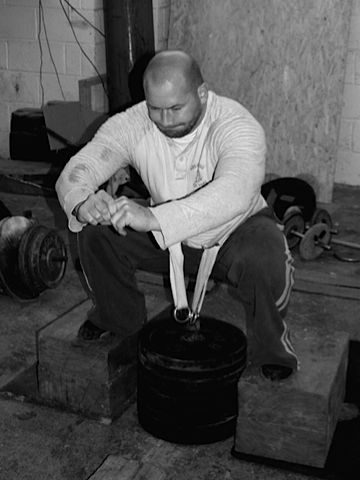
Beyond Strong's Nick McKinless demonstrates the Hip Belt Squat. Nice one.
 Looking to Be Fit and Strong? Curtis has a few ideas.
Looking to Be Fit and Strong? Curtis has a few ideas.
 This is a guest article by All-round Strength Training's Sally - 5 of the best exercises for all-round strength.
This is a guest article by All-round Strength Training's Sally - 5 of the best exercises for all-round strength.
There's more to all-round strength than just lifting a heavy barbell - although that's pretty important too. All-round strength is about being able to lift heavy, explosively and using the whole body.
All-round strength means a strong core and a strong grip, as well as a strong arm. If your leg press is out of this world but you can't do a pull-up with your own bodyweight, how strong are you really?
There are plenty of ways to get strong. Here are five of the best!
Deadlift
Performed with good form, this exercise will make you uber-strong. It will train back, legs, shoulders, core and grip. It also takes your central nervous system out for a sprint round the block! A good deadlift has a crossover effect on all your other exercises. This will probably be your heaviest lift, a real test of maximal strength.Snatch
This exercise is all about moving a heavy weight from the floor to above your head at speed. It requires real mastery of your body: balance, control and explosive power. If you've never tried it before, the one-arm dumbbell version is relatively easy to learn compared to the two-handed barbell version. This lift is unlike anything else out there. It will make you feel like a god or goddess of power!Pull-up
The ultimate test of bodyweight strength. It is amazing how many dedicated bench pressers cannot manage this exercise. Use a towel or ropes to make it harder and get even more grip training in.Sandbag clean and press
The sandbag version of the clean and press is more challenging than using a barbell or dumbbell. It's all very well lifting cleanly and clinically in the gym - can you also handle a weight that is awkward, unstable and difficult even to get hold of? Another great grip trainer to boot. Who needs hand grippers?!Sled push
Pushing a heavy sled is a full body workout. Legs, posterior chain, core, shoulders are all put through the mill, not to mention the cardiovascular system. This is Mike Boyle's answer to the question 'if you could only do one exercise, what would it be?'Which are your favourite exercises for all-round strength? While you're thinking about it, here's Eva T in an impressive display of strength!
Written for Straight to the Bar by Gubernatrix - on a mission to find the best in all-round strength training.
 Ski champion Eva Twardokens.
Ski champion Eva Twardokens.

Via American Gladiators Blog : MMA athlete Gina Carano is set to compete as the gladiator 'Crush' in the new series. Should be interesting.
 Looking for a quick protein hit? Jen points to Icelandic yoghurt, Skyr.
Looking for a quick protein hit? Jen points to Icelandic yoghurt, Skyr.
 Bodybuilder Aurélia Grozajová.
Bodybuilder Aurélia Grozajová.
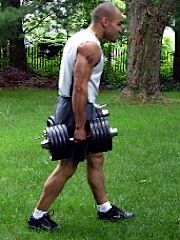 In this series Blaine and I will be looking at just some of the ways to take advantage of your location when it comes to working out. No matter what your idea of 'working out' is, there are several things you can do right where you are.
In this series Blaine and I will be looking at just some of the ways to take advantage of your location when it comes to working out. No matter what your idea of 'working out' is, there are several things you can do right where you are.
To kick things off, I'll be taking a peek at something which many of us can put to good use - a bit of outdoor space.
In 2005 I moved from Glasgow, Scotland to Sydney, Australia. I've done a fair bit of travelling over the years, so the logistics of shifting from one place to another weren't much of a problem (aside from the paperwork at customs, but that's another story).
What did stand out, however, was the big difference in the way I worked out. This consisted of :
- A tiny garage gym in Glasgow, without lights or heating - very much at the mercy of the elements
- During the trip itself there was very little exercise - aside from the stretching on the plane, and the mad running between flights
- In Sydney (before I set the main gym up) I used my father's all-in-one home gym - a large machine that covered most of the basic exercises
- Once the rack and free-weights were in place, it was back to business-as-usual (without the extreme cold, that is)
- As the weather in Sydney grew warmer, I gradually added outdoor training elements such as kettlebells, sandbags, a sledgehammer and odd objects (I just happened to find an old anvil lying around)
Through this experience I noted many things (including the fact that it would've been cheaper, quicker and easier to sell everything first and buy it again in Sydney). Today, however, I'll just be looking at one of them - the things you can do with a yard.
How big is the yard?
When I first arrived in Sydney, I stayed at my parents' house whilst looking for something a little more permanent. The house sits on a 1/4 acre block, which was pretty typical here at the time it was built (early 1970s).
This is roughly broken up into thirds, with a third each for front, house and back yards. Easily enough for a bit of football, a game of cricket and a dip in the kidney-shaped swimming pool. It's a great set-up.
Time for some serious outdoor workouts
This space immediately lends itself to outdoor training. This has included :
Plenty of kettlebell training : although there's no real reason why kettlebell training can't be performed indoors, the ceiling height here means it's definitely an outdoor pursuit. Especially when it comes to kettlebell snatches.
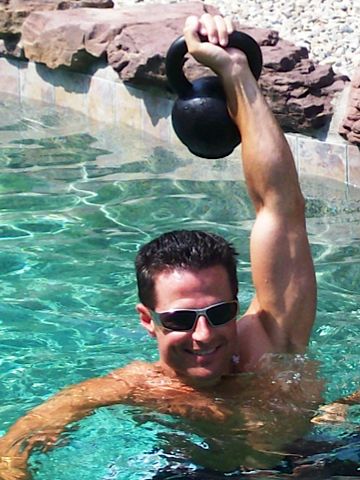 NB : I haven't yet tried this, but the idea of kettlebell training in the pool is definitely on the cards. Once summer really gets underway, of course.
NB : I haven't yet tried this, but the idea of kettlebell training in the pool is definitely on the cards. Once summer really gets underway, of course.
Sandbag work : again, this could be done indoors. However, there's always the feeling that one of these days a sandbag will burst, and, well, I'd rather be outside when it does.
Farmers' walks : I usually perform these with heavily-laden dumbbells, although I'm tempted to construct something a little more like this. The hardest part? Carrying them back into the house following a dumbbell Inman Mile. Love it.
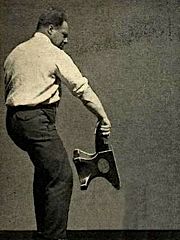 Odd objects : no matter how hard you try, there's no way to drop something like an anvil without making a dent in the ground. I'd rather have a hole in the dirt than broken floorboards.
Odd objects : no matter how hard you try, there's no way to drop something like an anvil without making a dent in the ground. I'd rather have a hole in the dirt than broken floorboards.
I also like lifting things that are already outside, such as the various stones, bags and machinery around the yard. Good fun.
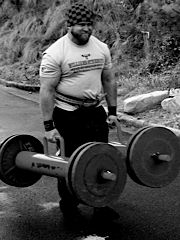 The Inman Mile is a great exercise; effectively a supersized version of a Farmers' Walk. Although there are several variations (see below), the most common versions are :
The Inman Mile is a great exercise; effectively a supersized version of a Farmers' Walk. Although there are several variations (see below), the most common versions are :
1.5 x bodyweight, barbell across shoulders : This is the version recognised by the USAWA, and occasionally appears at USAWA sanctioned events. Their definition is :
The lifter will have loaded onto his/her shoulders a weight equal to 150% of bodyweight. The lifter will then carry the weight a distance of one mile. Gait is optional. Resting is allowed, but neither the lifter nor the weight may be supported. Records will be kept in both pounds and time. Should the weight be touched by any aide once the lift has begun, the event is terminated. The lifter may be handed refreshments during the lift.
For obvious reasons, this is usually performed outdoors.
1.0 x bodyweight, dumbbells or Farmers' Walk handles : This is the same as above, with the major difference being the position of the weight. Not only is it much closer to the ground (although as my lawn will attest, it still carves out a chunk of dirt when you drop the bells), but there's a much greater emphasis on grip.
For this reason alone, the 1 x bodyweight is usually more than enough.
Where does the name come from?
I'm yet to confirm this one, but I suspect the footballer Jerry Inman may be behind it all. Or possibly Wayne Inman. Either way, it's an impressive feat.
Variations
As with most exercises, there are a number of ways to vary things a little. A few suggestions :
Reduce the load : 1.5 x bodyweight is a lot heavier than it sounds - particularly over that distance. And if you're doing an 'Inman Stroll' (same thing, over a distance of 1.5 miles); it'll get old in a hurry.
Try cutting back the load a bit - especially when you're just getting used to it. Your traps will still be acutely aware of the exercise.
Reduce the distance : the other obvious change is simply to reduce the distance. After all, a mile is an exceptionally long way to carry that sort of weight.
Work up to it.
Allow the weight to be put down during rest breaks : this one makes a big difference. When it comes time for a pause, put the weight down. It'll still be there when you start up again.
Use a Strongman Yoke : if you've got access to one, use a Strongman Yoke. This is a great piece of equipment, and is perfect for exercises like this.
Other things to consider
Try the dumbbell version before considering the barbell : although the weight doesn't sound too bad - particularly if you're used to performing Farmers' Walks - it's the distance that will get you. A mile or a mile and a half is a long way when you're loaded up.
When you try this for the first time, use dumbbells or Farmers' Walk handles. Although this really brings your forearms into play, it keeps the weight nice and close to the ground. Much safer when it comes to setting them down, and taking a few deep breaths.
Leave the equipment outside (covered) : At the start of each workout, you probably won't mind the time you spend carrying everything up the stairs from your basement, and setting up outside. The same goes for the lap after lap of the workout itself - adrenalin will keep you going.
When it comes to the end of the session, however, you won't exactly feel like carrying everything back inside. If possible, leave it outdoors - covered, and set up ready for next time.
Final thought
This is a great exercise, whether you make the full distance or not. Oh, and it's also the perfect time to try out that Manta Ray you got a while ago.
